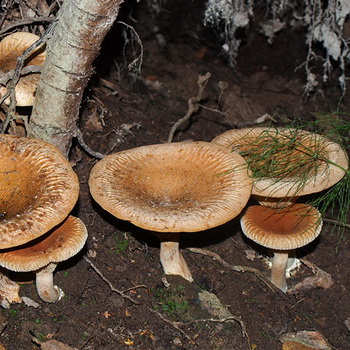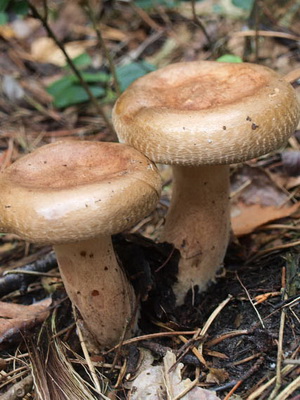Thin pig: edible or not, video, photos of the differences from the fat pig, places of distribution
 The pig mushroom is well known to experienced mushroom pickers and is very popular among culinary specialists. It can be started in the summer and finished almost in late autumn. However, there is such a mushroom as slender pig, which is very similar to edible, but is considered poisonous. This fruiting body is capable of accumulating harmful substances and synthesizing the most dangerous poison called muscarine. It can be equated to the poison of the red fly agaric.
The pig mushroom is well known to experienced mushroom pickers and is very popular among culinary specialists. It can be started in the summer and finished almost in late autumn. However, there is such a mushroom as slender pig, which is very similar to edible, but is considered poisonous. This fruiting body is capable of accumulating harmful substances and synthesizing the most dangerous poison called muscarine. It can be equated to the poison of the red fly agaric.
Name piggy thin(Paxillus involutus) means "bag or small bag". The definition in the Russian name arose due to the fact that the young fleshy caps of this type of mushroom are very reminiscent of pork ears.
The poisonous mushroom, pig slender, is widespread in all countries where a temperate climate prevails. This fruiting body grows in mixed, deciduous and coniferous forests. However, most often the poisonous mushroom prefers to grow in clarified glades, forest edges and on the outskirts of marshy areas. Less often, pigs grow on the rhizomes of trees, which are turned upside down by a strong wind. We offer you to see a photo of a thin pig mushroom that grows in such conditions.
Where does the slender pig grow?
Many experienced mushroom pickers collect the pig and eat it. But novice lovers of "quiet hunting" are at a loss: Is the slender pig edible or not? This mushroom is found in almost all regions of Russia and is characterized by massive fruiting and a great similarity with edible pigs. In many localities, it is considered conditionally edible and is eaten after a long soaking and boiling for 1 hour. But experts say that in fact all this does not correspond to the true state of affairs. In the mid-1990s, all pigs were officially considered poisonous mushrooms. Their venom can be fatal from kidney failure.
The slender pig grows throughout Russia, as well as in the countries of Eastern, Southern and Central Europe. This mushroom can even be found in young forests with a predominance of birch and oak, which are not even 10 years old. Sometimes they can settle on tree trunks in small groups. However, the slender pig bears fruit very often and is characterized by a long fruiting period - from early July to mid-October.
In real conditions in the forest, when collecting mushrooms, it is very difficult to recognize a poisonous slender pig. Therefore, we suggest that you read and, if possible, remember the presented photo and description of the thin pig mushroom, so as not to expose yourself and your loved ones to the negative effects of its poisons.
What a slender pig (Paxillus involutus) looks like
Latin name:Paxillus involutus.
Family: piggy.
Department: basidiomycot.
Class: agaricomycetes.
Synonyms: pig, cow, filly, pig, pig, pig's ear.


Hat: reaches sizes from 10 to 20 cm in diameter, but more often sizes do not exceed 15-17 cm. Young pigs have a slightly convex cap and curled edges. Middle-aged specimens have a flat and slightly depressed cap that becomes funnel-like at maturity. The color ranges from olive to gray-brown. It becomes sticky and slippery in rainy weather and high humidity.
Plates: as such are absent. The hat has pseudo plates called Hymenophores.


Leg: has a length of no more than 10 cm, in diameter is about 2 cm. The surface is smooth, upon contact with the skin, a velvety feeling is observed. The color is the same as that of the cap, sometimes a little lighter.
Pulp: at a young age, dense, thin and soft, and at maturity - loose and wormy. If you break off a piece from the cap, the flesh immediately darkens.
Edibility: poisonous mushroom, when broken in any part of the mushroom, the pulp immediately becomes an unpleasant brown color and the smell of wood appears, more reminiscent of the smell of decay.
Spreading: throughout Russia in mixed, deciduous and coniferous forests, preferring darkened, humid areas. Fruiting begins from June to mid-October.
We suggest watching a video showing a slender pig during the mushroom season:
In addition, the most common types of this poisonous fruiting body include not only a thin pig, but also a thick pig. Look at the photo of the difference between a thin and thick pig:


It is worth noting that the plump pig is a rare species of fungus found only in countries with a temperate climate. She chooses the main place for growth in coniferous forests, where there are many trees upturned by the roots, rotten stumps and moss.
The shape of the cap is slightly different from the thin pig and looks more like an elongated tongue. Reaches up to 20 cm in diameter, has a brown or brown color. The surface is velvety, dries up and cracks in adulthood. The leg is short, with a fleecy coating, dense and shifted to the edge of the cap.
These mushrooms begin to bear fruit in early July and grow until the end of autumn, but they are extremely rare. Sometimes they can grow on the ground, on the roots of trees and old stumps in the coniferous forest.
After reading the description of the slender pig and learning what this poisonous mushroom looks like, you will never collect it. Remember that it is capable of synthesizing the dangerous poison muscarine, which is equivalent to the poison of the red fly agaric. In addition, the thin pig accumulates in itself a huge amount of salts of heavy metals, as well as radioactive substances - copper and cesium, which leads to death.










